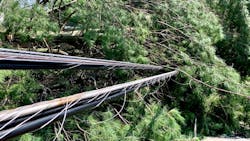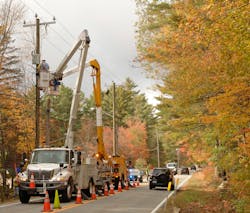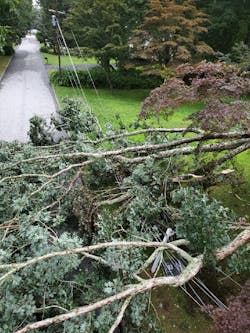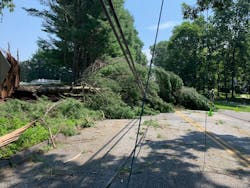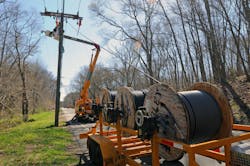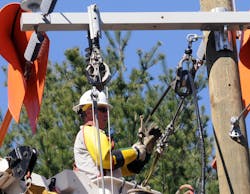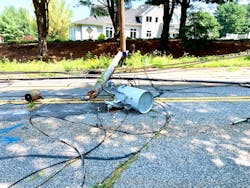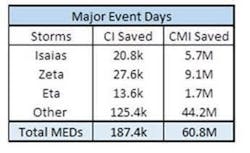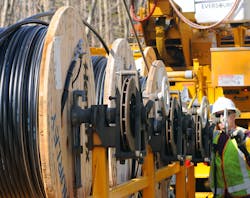Before the first raindrop even falls or wind gust causes damage, however, companies are already planning and preparing for whatever Mother Nature hurls at them.
For example, Duke Energy Florida is investing in a storm protection plan to strengthen its grid. In addition to trimming trees, and inspecting and replacing wires and wood poles, the company is investing in grid automation and smart technologies to reduce the duration and number of outages and expedite restoration. Linemen will also upgrade poles and wires most prone to damage during extreme weather events and improve existing underground lines and equipment to withstand a storm surge.
Through its Storm Protection Plan, Duke Energy will invest about $6.5 billion over the next decade to strengthen the state’s energy grid and make it more resilient and secure. The company is also striving to improve reliability for customers and reduce the number and duration of outages, said Brian Lloyd, general manager of major projects. “Storms are increasing in frequency and severity,” Lloyd said. “That’s why we must take steps now to strengthen the grid and make it more resistant to outages from severe weather.”
By hardening their transmission and distribution systems and rolling out the latest technologies, utilities are taking a proactive approach to storm restoration. Here’s how Duke Energy, American Electric Power (AEP) and Eversource are mitigating damage and boosting reliability for their customers.
Reducing Tree-Related Outages
Trees are one of the number-one causes of power outages during storms, and utilities are taking action to reduce the potential for power disruptions to their customers. Eversource invests tens of millions of dollars annually to strengthen its delivery system. For example, linemen have installed thousands of new, stronger poles and thicker “tree wire” throughout the utility’s service territory.
Eversource’s comprehensive year-round tree work program remains a major part of preparedness efforts, with trimming and removal of trees and vegetation — to the extent property owners allow — to reduce the risk of outages in all weather conditions. Recently, the utility launched a new partnership with 16 communities hardest hit by Tropical Storm Henri to survey trees near electric power lines and equipment. By proactively addressing hazardous trees and branches, Eversource aims to prevent future outages and public safety issues.
“As we saw with Henri, trees continue to be the number one cause of electrical outages for our customers — in addition to causing property damage and public safety issues like blocked roads,” said Eversource Vegetation Management Manager Sean Redding. “A single tree-related outage can have a compounding effect, including broken poles, downed trees and/or wires, a broken transformer or crossarm. These outages can impact critical facilities like hospitals, police and fire stations and are labor-intensive and time-consuming to restore.”
Not only Eversource, but also AEP, is hardening its system. Linemen are replacing aging transmission infrastructure with more resilient and often higher capacity infrastructure. Earlier this year, 20 transmission improvement and rebuild projects were in progress in the company’s West Virginia service area.
The utility is also zoning in on vegetation management. Following the 2012 derecho, the Public Service Commission of West Virginia directed all electric utilities in the state to review their vegetation management practices and present recommendations for improvement. In 2014, AEP moved from a worst-performing circuit approach to a cycle-based approach, in which vegetation on all circuits is managed end-to-end every six years. With the first cycle of vegetation management complete, outages caused by within the rights-of-way dropped more than 60 percent.
No amount of right-of-way clearing, however, could have prevented damage from the number and size of trees brought down by a mid-February storm. A series of destructive ice storms moved through southern Ohio, Kentucky and West Virginia starting Feb. 10 caused widespread power outages and major damage to power lines and other electrical facilities. Another round of ice came through on Feb. 15. Snow followed a week later, which made working conditions more difficult but didn’t cause significant additional outages. And then at the end of the restoration, flooding from extensive rain occurred causing moderate problems for outages.
One factor that made service restoration so difficult was the persistence of ice, which built up in thickness through back-to-back storms. As weather remained cold and cloudy, ice stubbornly weighed heavy on trees and electric infrastructure for more than 12 days. This created additional damage and outages each day as trees and limbs broke under the weight. Ice made for hazardous road conditions throughout the restoration effort and presented difficulties accessing job sites, climbing poles, clearing trees and handling wire and equipment.
Following the storm, however, clearer rights of way (ROWs) from cycle-based vegetation management allowed workers far easier access and reduced the time needed to locate problems and make repairs. APCo line mechanics and supervisors estimated that improved ROW saved a day of extra restoration.
Investing in New Technology
Electric utilities are not only making their systems more resilient through a focus on system hardening and vegetation management, but they are also rolling out new technologies to expedite restoration. For example, Eversource has installed smart grid equipment such as “smart switches” to enable system operators to isolate power outages and remotely reroute power from another source within minutes.
In addition, smart fuses automatically restore power to customers when a tree limb temporarily contacts wires and help to protect the electric system when a problem is detected. Also, optical ground wire (OPGW) enhances communication between company facilities and protects the high-voltage transmission system from severe weather conditions, such as lightning strikes.
At AEP, crews have installed “smart circuit” technology to speed restoration by pinpointing a fault location and automatically switching customers outside the damaged area back in service. More than 20 of AEP’s West Virginia distribution circuits have this technology in operation, and several more projects are underway.
In the utility industry, the transformation in technology moves at an aggressive pace—especially in storm response, said Lloyd of Duke Energy.
Over the next three years, Duke Energy Florida will invest more than $5 billion to enhance reliability with fewer outages and shorter restoration times. For example, in 2019, the company started installing TripSaver devices on power lines to help limit the frequency and duration of service interruptions. TripSavers are installed on local power lines that branch from the main power lines serving an area and are essentially similar in action to a recloser. Duke Energy Florida installed 300 TripSavers in 2019, 1,600 in 2020 and is projected to install 6,500 in 2021.
“When there is a temporary issue that could cause an outage requiring a first responder, TripSaver responds in seconds to clear a temporary fault resulting in the customer experiencing no outage,” said Ana Gibbs, media relations for Duke. ”In addition, by containing issues at the feeder level and isolating them as a localized event, TripSavers allow the company to reduce its overall exposure to momentary outages, power quality complaints and fault tolerance of branch lines.
The utility is also deploying other technologies to save time for linemen during storm restoration. In the past, line crews previously had to physically inspect miles of power lines to ensure that all the customers’ power was restored, which was very time-consuming. Today, the Duke Energy crews use a technology called “Ping-it” to remotely confirm an outage in seconds.
“Ping-it sends a signal to each smart meter to ensure that repairs successfully restored electricity to each individual customer without rolling a bucket truck,” Lloyd said.
Duke Energy Florida just completed installing smart meters for its 1.9 million customers, and company-wide, technicians have installed more than 8.5 million smart meters. As such, the utility is providing new technology to better serve customers in six states.
Case in point: during Tropical Storm Zeta, smart meter technology helped to avoid more than 2,300 truck rolls to verify if power had been restored—freeing up crews and speeding up restoration for all customers.
Beyond smart meter technology, Duke Energy has also invested in self-healing technology, which helps to reroute power and reduce outage times. “Duke Energy’s smart-thinking grid automatically detects outages and intelligently reroutes power to speed restoration or avoid outages altogether,” Lloyd said.
Self-healing technology reroutes power — much like GPS reroutes a driver through a traffic jam — to reduce the number of customer outages during an event. In fact, it can reduce the number of customers impacted by as much as 75% and can often restore power in less than a minute.
In 2020, smart, self-healing technology helped to avoid nearly 290,000 extended customer outages in Florida, saving around 18.9 million outage minutes, which is double the hours saved in 2019. Since beginning the self-healing technology program, Duke Energy Florida has prevented more than 70 million outage minutes for customers.
The technology can help to reduce outage times following severe storms like hurricanes, it works year-round. For example, if Duke Energy’s service territory experiences an afternoon thunderstorm or a tree hits a line, the technology springs into action.
“This technology serves about 45% of our Florida customers, and we expect that smart-thinking technologies will serve 80% or more of customers when fully deployed by 2027,” Lloyd estimated.
To further reduce the duration and frequency of outages, Duke Energy’s linemen install reclosers, which is infrastructure added to the power lines to reroute power. In more dense populations, such as cities, the utility is able to isolate outages to about 400 customers, where previously, the same outage could take out more than 2,000 customers. In more rural areas, the technology isolates outages to three miles of line of 2 MW of load.
Predictive modeling of outages is another way Duke Energy is planning ahead for severe weather. The utility can better stage resources before a hurricane or when to hold resources over in preparation for afternoon thunderstorms, allowing Duke Energy to be more responsive to outages.
Performing Aerial Inspections
Electric utilities are investing in technologies to prepare for severe weather. Also, they are using aerial inspections with drones and helicopters to pinpoint damage and more quickly mobilize line crews following a storm.
For example, during the mid-February ice storm, AEP used drones and helicopters to assist with damage assessment. Weather prohibited the use of helicopters at times, and on the really cold days, drones iced over in the air. Even so, the use of drones for damage assessment proved valuable for damage assessment, particularly in situations where weather hindered assessment by helicopter or ATV.
Eversource is also using drone technology following severe storms. Drone crews patrol distribution circuits looking for damage that has caused an outage or could cause a future outage. That information is then relayed to the operations team so they can deploy a crew to fix the problem as quickly and safely as possible.
“Drones allow us to quickly patrol circuits during a storm in areas when they are otherwise not accessible by foot or by car,” said Elizabeth Hall, lead engineer, drone engineering, for Eversource. “The drones provide images and details of damage in those areas, making the damage assessment process more efficient so that the lineworkers can get their job done quicker. Among its significant potential, I ultimately foresee drones as an advancement of our commitment to safety at Eversource, minimizing the need to put humans at risk with electrical hazards.”
For example, in one case, the drones identified a bent crossarm and wire down due to a falling tree in an area only accessible by the drone. Drones can discover more damage than other means of inspections during storms due to their ability to fly closer to the infrastructure. If damage exists, the drones can capture a clearer image. The videos from drones can also aid in the communication efforts company-wide during a storm.
“The potential applications of drones in our industry advance each year,” Hall said. “From routine inspections to incorporating pictures and videos in different processes today, to the emergence of machine-learning techniques that will be a major part of storm restoration efforts in the future, drones continue to have great untapped potential as a valuable tool for our industry. And although Eversource hasn’t strung wire with the assistance of a drone during a storm, we hope to be doing so in the near future as well.”
Eversource is using drones for inspections where it used to use helicopters or foot patrols. Time savings vary based upon each specific situation.
“If a quick patrol is needed over a large area, drones wouldn’t typically save time,” Hall said. “If we are only looking at a small section, or need more advanced data for analytics, drones are the better option.”
At Duke Energy, the utility is using a combination of helicopters and drones to perform inspections and respond following storms. Because helicopters can travel faster and farther than drones, they are used as the primary tool for damage assessment.
Duke Energy has a fleet of helicopters dedicated to asset inspection, and the utility inspects 32,000 miles of line twice a year, said Jacob Velky, director of aircraft operations, travel and event management for Duke Energy. Transmission and vegetation employees ride along with the helicopter pilot to perform a visual inspection to patrol the transmission lines.
Drones, however, have changed the way Duke Energy performs inspections. Last year, the utility installed cameras on its helicopters to collect standard RGB imagery as well as thermal images.
“Use of these sensors helps us to detect equipment problems along our infrastructure,” he said. “The cameras on these helicopters allow us to do desktop inspections and reduce the amount of time our linemen are in the helicopters.”
Right now, an employee can review the video from his or her desk, but in the near future, Duke Energy plans to transition completely to this type of inspection. One day artificial intelligence may even be able to self-detect problems on the lines, he said.
Through the video inspections, Duke Energy can have a permanent record of its system. As such, the employees can go back and compare what they have previously found or experienced on a line. Damage that is discovered can vary widely.
“It can range from topped trees, which hit our line, to much more impactful damage such as infrastructure that is severely damaged,” Velky said.
During storms, drones can provide detailed inspections to aid with restoration and rebuilding efforts. Currently, Duke Energy has nearly 100 transmission line techs who are trained to operate the drones during storms and other times throughout the year.
“Drones offer a unique positioning advantage in that multiple operators can be safely deployed simultaneously,” said Jackson Rollins, unmanned aerial systems manager at Duke Energy. “During times when debris and other obstacles may be in the way of reaching our resources, having this aerial view reduces the risk of line techs walking in the right of way, reduces the risk of slips, trips and falls, and ultimately provides a safe environment for our employees.”
Duke Energy first started using drones for storm damage assessment following Hurricane Matthew in 2016. Crews were not able to drive through the flooded roads in the Carolinas, but with the drones, the team could inspect power lines and vegetation. Since then, the team has used drones after Hurricane Irma in 2017 to find safe paths for crews to assess equipment without walking or driving through swamps.
Expediting Restoration
Following Hurricane Maria, the crews also used drones to install lines in Puerto Rico. After determining the distance between the two poles, the linemen used a 2 ½ ft by 2 ½ ft drone to carry a lightweight, nylon parachute cord. The drone team designed and 3D printed an electromagnet that allows them to drop the cord with precision. The magnet also provides a level of safety. If the rope becomes tangled or the mission needs to be aborted, the linemen can drop the rope and bring the drone back to safety.
Duke Energy tested the process in Indiana in a swamp area of North Carolina before heading to Puerto Rico, where they strung 9,000 ft of cord. The longest strand was 1,200 ft, a little longer than three football fields.
In Puerto Rico, the alternate option for stringing the lines over long distances, thick vegetation or deep ravines, was shooting a brass projectile attached to a nylon cord, from a shotgun.
“This method has worked well for years, but it has limitations in accuracy and distance,” Rollins said. “The maximum range for the gun is about 800 ft, and many of the power poles in Puerto Rico are farther apart than that. If the shooter misses, he or she has to walk through the brush to find the projectile and try again.”
This work method was born out of necessity, Rollins said. Since that time, however, the crews have pulled thousands of feet of string outside of storm response. More recently, the utility has begun the pilot phase of using drones for water quality sampling.
“It’s exciting to see a trend of using drones to perform tasks in addition to being used in the traditional data capture process,” Rollins said.
Through a proactive, rather than a reactive approach, electric utilities are discovering new ways to prepare for severe storms. When the clouds roll in, and the rain, snow or sleet begins to fall, they are ready to restore power and rebuild infrastructure and keep the lights on in their communities.
Amy Fischbach ([email protected]) is the Field Editor for T&D World magazine.
About the Author
Amy Fischbach
Electric Utilities Operations
Amy Fischbach is the Field Editor for T&D World magazine and manages the Electric Utility Operations section. She is the host of the Line Life Podcast, which celebrates the grit, courage and inspirational teamwork of the line trade. She also works on the annual Lineworker Supplement and the Vegetation Management Supplement as well as the Lineman Life and Lineman's Rodeo News enewsletters. Amy also covers events such as the Trees & Utilities conference and the International Lineman's Rodeo. She is the past president of the ASBPE Educational Foundation and ASBPE and earned her bachelor's and master's degrees in journalism from Kansas State University. She can be reached at [email protected].
